VOL.45, NO. 3
“Keep your head”: Almereyda’s Cymbeline and “The Legend of Sleepy Hollow”
Michael D. Friedman
Director Michael Almereyda’s cinematic version of Cymbeline (2014) begins with a short sentence in white print against a black background: “Keep your head.” This credit literally refers to Keep Your Head Productions, a company founded by Anthony Katagas in 1999 to encourage the creation of independent films in New York City (“Anthony”). Viewers unfamiliar with this organization may, however, take the sentence as an admonition, directed at the audience, to remain calm and composed during the film. Others, especially those conversant with the plot of Shakespeare’s play, may be more likely to interpret it as a warning intended specifically for Cloten, the son of the play’s evil Queen, who loses his head both metaphorically, by quarreling with King Cymbeline’s lost heir, Guiderius, and literally, by suffering decapitation at the hands of the young prince. With this initial evocation of the specter of a beheaded body, the film takes its first step toward conjuring up the horrific figure of the Headless Horseman, featured in the classic American story that offers Almereyda a pattern for his relocation of Shakespeare’s romance from ancient Britain to the contemporary United States: Washington’s Irving’s “The Legend of Sleepy Hollow.”
Film directors frequently transport Shakespeare’s plays from their original settings to places and times that better suit the directors’ intentions. When this new setting is modern America, the films produced tend not to be “versions” of the plays, which use primarily Shakespeare’s own language (in edited form), but “adaptations” that borrow the basic plotline, characters, and thematic issues from a particular drama but employ the contemporary vernacular almost exclusively in their dialogue (Friedman 3). For example, Joe MacBeth (1955), West Side Story (1961), Just One of the Guys (1985), Men of Respect (1990), My Own Private Idaho (1991), A Thousand Acres (1997), 10 Things I Hate about You (1999), Never Been Kissed (1999), Get Over It! (2001), “O” (2001), Scotland, PA (2001), and She’s the Man (2006) are all unequivocally set in America and mirror the action, characters, and themes of Shakespeare plays, but none of them reproduce his dialogue in a sustained way, presumably due to the concern that Shakespeare’s early modern English will sound unnatural in the mouths of present-day Americans. Before the release of Cymbeline, two rare exceptions to this practice included director Joss Whedon’s Much Ado About Nothing (2012) and Almereyda’s own Hamlet (2000), whose scripts were both based on Shakespeare’s texts.1 With regard to Much Ado, Shakespeare’s original location (Messina) plays no crucial role in the comedy’s import, so Whedon’s transportation of the events to Santa Monica, California does not remove from the play any element vital to its meaning. Hamlet and Cymbeline, however, deal extensively with the specific political circumstances of the countries in which they take place, and, therefore, Almereyda may be considered the only major modern director of film “versions” of Shakespeare’s plays whose relocation of the action to the United States bears a particular political significance.
Almereyda approaches Cymbeline with the intention to create “a willfully American version with American characters and an American subtext” (Rome). This choice impels him to eliminate from the film one of the political aspects of the play that has most intrigued modern critics: its “central and profound preoccupation with origin myths,” specifically “the origins of Britishness, ancient and early modern, from Roman times to the Henrician Reformation and beyond” (Maley 149).2 Jodi Mikalachki perceives, in the work of early modern English playwrights and historians, a tension between their aspiration to establish continuity with their nation’s past and their concurrent desire to “exorcise a primitive savagery [they] wished to declare obsolete” (302). In order to reconcile these two conflicting wishes, Mikalachki argues, such dramatists and historians blamed influential ancient women for their patriotic yet barbaric resistance to the civilizing effects of the Roman subjugation of Britain:
One of the great intellectual stumbling blocks to the recovery of national origins in sixteenth-century England was the absence of a native classical past on which to found the glories of the modern nation. Worse yet, the primitive British savagery that purportedly preceded Roman conquest proved antithetical to a fundamental principle of hierarchy in early modern England, for the Britons made no distinction of sex in government. Powerful females loomed large in early modern visions of national origins, from the universal gendering of the topographical and historical “Britannia” as feminine to the troubling eruptions of ancient queens in the process of civilization by Rome. Like the unruly women who challenged the patriarchal order of early modern England, these powerful and rebellious females in native historiography threatened the establishment of a stable, masculine identity for the early modern nation. (302-3)
This demonization of female rulers for their nationalistic, yet savage defiance of Rome is clearly present in Shakespeare’s portrayal of the Queen, who exhorts King Cymbeline to refuse to pay the tribute demanded by Augustus Caesar:
Remember, sir, my liege,
The kings your ancestors, together with
The natural bravery of your isle, which stands
As Neptune’s park, ribbed and paled in
With oaks unscalable and roaring waters,
With sands that will not bear your enemies’ boats,
But suck them up to th’topmast. A kind of conquest
Caesar made here, but made not here his brag
Of ‘came, and saw, and overcame’. With shame—
The first that ever touched him—he was carried
From off our coast, twice beaten, and his shipping,
Poor ignorant baubles, on our terrible seas
Like eggshells moved upon their surges, cracked
As easily ’gainst our rocks. For joy whereof,
The famed Cassibelan, who was once at point—
O giglot Fortune!—to master Caesar’s sword,
Made Lud’s town with rejoicing fires bright,
And Britons strut with courage. (3.1.16-33)3
In order to convince her husband to throw off the yoke of Rome, the Queen jingoistically reminds Cymbeline of the bravery of his royal predecessors, especially Cassibelan, to whom Shakespeare attributes the defeat of Julius Caesar. She succeeds in her intent at this juncture, but near the end of the play, Cymbeline unexpectedly repudiates the potentially attractive nationalism advocated by the Queen and chooses to accept a position subordinate to the Roman invaders whom he has just defeated:
Although the victor, we submit to Caesar,
And to the Roman empire, promising
To pay our wonted tribute, from the which
We were dissuaded by our wicked Queen,
Whom heavens in justice both on her and hers
Have laid most heavy hand. (5.5.459-64)
Cymbeline’s sudden about-face allows the play to celebrate Britain’s origins in the masculine civilization of Rome while simultaneously attributing the nation’s violent resistance to imperial subjugation entirely to the “wicked Queen,” who receives (along with her son) divine punishment for the female savagery of her patriotism. In place of the “rejoicing fires bright” that hailed the “courage” of Cassibelan, Cymbeline calls for a “Roman and a British ensign” to “wave / Friendly together” in Lud’s town at the play’s conclusion (5.5.479-80).
Almereyda omits from his script all of the play’s references to the pre-Christian history of Britain, including the Queen’s vehement paean to the bravery of the ancient Britons. As he acknowledges in an interview, “So there’s a whole element of Cymbeline that I cut out or minimized, that has to do with national identity, about the British empire, and that obviously didn’t translate into a version that’s set in America with American actors, with themes that seem particular to the moment” (Mears). To compensate for the loss of this pagan mythological underpinning (what he calls, in his DVD Director’s Commentary, a “creation myth about the British Empire”4), Almereyda substitutes a different pagan foundation derived from “The Legend of Sleepy Hollow,” which has served as the origin myth for the American celebration of the holiday now known as Halloween.5
Cultural historians trace the roots of Halloween back to the Celtic festival of Samhain, on the eve of which, it was believed, “the dead rose” and “ancestral ghosts and demons were set free to roam the earth” (Bannatyne 2). Eventually, Samhain was co-opted by the Catholic Church, and the name of the modern holiday stems from its later incarnation:
Halloween is, quite literally, the popular derivative of All Hallow Even, or the eve of All Saints’ Day (1 November). Taken together with All Souls’ Day, which falls on 2 November, it is a time assigned in the Christian calendar for honoring the saints and the newly departed. In past centuries, it was also the occasion for praying for souls in purgatory. Yet because Halloween is popularly associated with the supernatural, it is often believed to have strong pagan roots that were never eliminated by the holiday's subsequent Christianization. (Rogers 11)
In early modern England, the season of All Saints’ and All Souls’ was known as Hallowmas, when it was customary for the poor to beg for food, specifically “soul cakes” made from oatmeal and molasses, in exchange for prayers for the dead (Skal 23). Shakespeare’s familiarity with this tradition is evident in The Two Gentlemen of Verona, when Speed recognizes, as one sign that his master is in love, Valentine’s tendency “to speak puling, like a beggar at Hallowmas” (2.1.24). Folklorists record that, during Hallowmas in Lancashire, adventurous individuals might engage in a custom called “Leeting the Witches,” which involved carrying a lighted candle through the hills between the hours of eleven o’clock and midnight to scare off evil spirits, who were reputed to gather at that time: “If the candle continued to burn during this ‘witching hour:’ then the carrier would enjoy an immunity from witches for the coming year” (Rogers 32). Shakespeare makes reference to this cursed hour in Hamlet, when, at the beginning of his soliloquy in 3.2, the Prince observes, “’Tis now the very witching time of night, / When churchyards yawn and hell itself breathes out / Contagion to this world” (3.2.387-89).6 “The Legend of Sleepy Hollow” later echoes Hamlet’s reference to supernatural folklore when Irving schedules his main character’s encounter with the Headless Horseman during the same sinister hour: “It was the very witching time of night that Ichabod, heavy hearted and crest fallen, pursued his travel homewards, along the sides of the lofty hills which rise above Tarry Town” (291). This Shakespearean allusion helps Irving to create the supernatural atmosphere that has cemented the association between his story and the celebration of Halloween in modern times.
Almereyda has claimed that he set his film version of Cymbeline during the week of October 31 because Halloween is “a kind of pagan ritual that persists to this day, and it also allows a way of thinking about the presence of death and a proximity of death to daily life, the kind of cheerful acknowledgement of death that is a bit like a Tim Burton movie,7 except I think a little more dire” (Rome). In his Director’s Commentary, Almereyda also reveals that, in an early version of the screenplay, the film “began with a kind of biker bash, with Halloween revelry and ghouls and goblins and motorcycles in [a] fairground.” This opening was eventually discarded for budgetary reasons, but Almereyda ultimately develops several less expensive means to keep the holiday in the forefront of the viewer’s mind. By including in his mise-en-scène the traditional trappings of the modern observance of Halloween, particularly those elements that derive from Irving’s short story, Almereyda represents the play’s mythos of dismemberment and death in a peculiarly American idiom.
Filmed in and around New York City, not far from Sleepy Hollow itself, the movie situates the action in an unnamed American town,8 where the “Britons,” a motorcycle gang led by “the King,” Cymbeline, refuse to pay bribes as “tribute” to the corrupt Roman Police Force.9 During the first half of the film, nearly every room is decorated with cobwebs and Halloween images in black silhouette, including bats, cats, and spiders. The Queen sings Bob Dylan’s “Dark Eyes” for an audience of bikers wearing masks and other costumes. While Iachimo attempts to seduce Imogen at Cymbeline’s mansion, the doorbell rings and a group of children can be heard in the background exclaiming “Trick or Treat!” At the beginning of the scene in which the Chief of Police, Caius Lucius, attempts to collect the Britons’ tribute, Cloten spills hundreds of silver Hershey’s kisses on the table, offering the Roman mere candy, the currency of Halloween, rather than the graft payment that he seeks. However, the most meaningful of the film’s Halloween images are three figures that initially gained an association with the holiday through Irving’s legend: the skull/skeleton, the pumpkin/jack-o'-lantern, and the scarecrow, all of which coalesce, to some degree, in the figure of the Headless Horseman. Although Halloween is never actually mentioned in the “The Legend of Sleepy Hollow,” and the holiday was not even celebrated by the Dutch settlers depicted the tale (Skal 35), the story has, nevertheless, been designated as “the first popular rendering of American Halloween” (Bannatyne 61).
The film’s first visual depiction of the Headless Horseman occurs in a wordless segment that follows the opening scene of Posthumus’s banishment from Cymbeline’s kingdom. Two children, a girl in a blue satin dress and a boy wearing the Halloween costume of a skeleton, stand holding hands on a street corner. Instead of a skull, the boy sports a black bag over his head (which would, in darkness, make him appear to be headless), and he carries a plastic pumpkin as a trick-or-treat basket. This image conflates various details from the portrayal of the Headless Horseman in Irving’s story. When Ichabod Crane catches his first glimpse of his pursuer, the figure is “muffled in a cloak” and carries his head (which later turns out to have been a pumpkin) on his saddle in front of him (Irving 293). Earlier in the story, the narrator provides an account of another citizen’s confrontation with the apparition:
The tale was told of old Brouwer, a most heretical disbeliever in ghosts, how he met the horseman returning from his foray into Sleepy Hollow, and was obliged to get up behind him; how they galloped over bush and brake, over hill and swamp, until they reached the bridge, when the horseman suddenly turned into a skeleton, threw old Brouwer into the brook, and sprang away over the tree tops with a clap of thunder. (290)
In Almereyda’s film, the headless skeleton carrying a pumpkin is approached by a young adult male wearing a black hoodie, whom the audience initially sees only from the back. This figure, based on his clothing, is the exiled Posthumus, and as he turns toward the headless skeleton, we observe that Posthumus is wearing a Halloween mask of the skull that the skeleton lacks (see Figure 1). As Almereyda reveals in his Director’s Commentary, “The cheerful skeleton is a motif, and I attach that to Posthumus.”
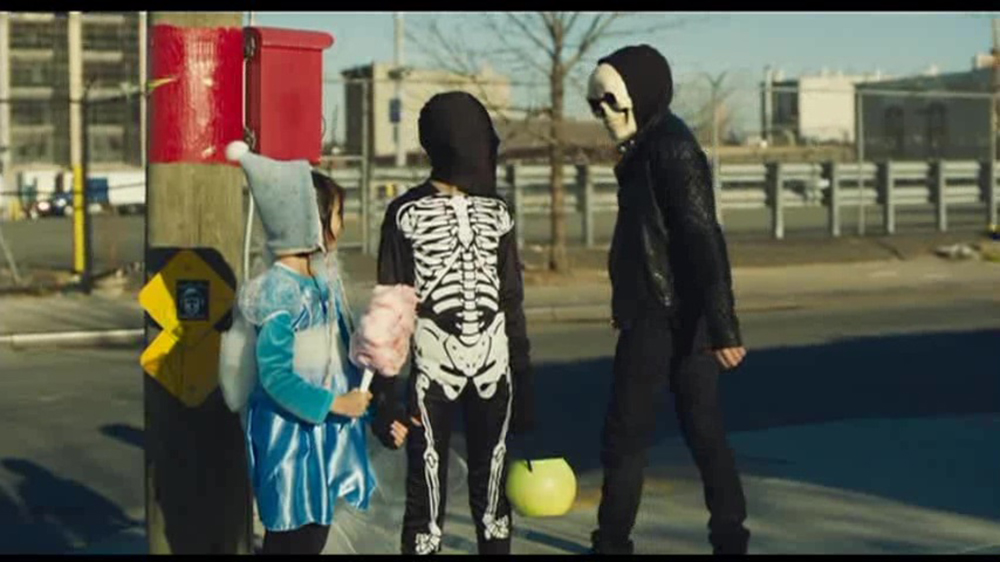
Within the film, Posthumus is the character most closely associated with the pagan rituals of Halloween that allow for a cheerful acknowledgement of death. In his first appearance on screen, Posthumus wears a red T-shirt with a black skull emblazoned over his heart (see Figure 2), which he later sends to Imogen from banishment as a memento. Subsequently, Iachimo delivers to Imogen a woodcut on brown paper that we observed Posthumus creating in the scene immediately preceding Imogen’s receipt of the T-shirt in her bedroom. This woodcut, inspired by the image of the two young trick or treaters, shows a woman standing with her arm around a skeleton whose skull resembles the one on Posthumus’s T-shirt. The skeleton holds an emblem that reads, “Fear No More” (see Figure 3). In Shakespeare’s play, this phrase begins the dirge “Fear no more the heat o’th’ sun” (4.2.257-80) sung by Guiderius and his brother Arviragus over the body of Imogen (disguised as the boy Fidele) whom they believe to be dead. In its original context, this lament offers the consolation that the deceased no longer must dread the hardships of life, but in the film, as the caption for Posthumus’s engraving, “Fear No More” is a reassuring message from a husband to his wife, imploring her to abandon her trepidation at their estrangement. If not before, they will ultimately find a “cheerful” reunion in death.
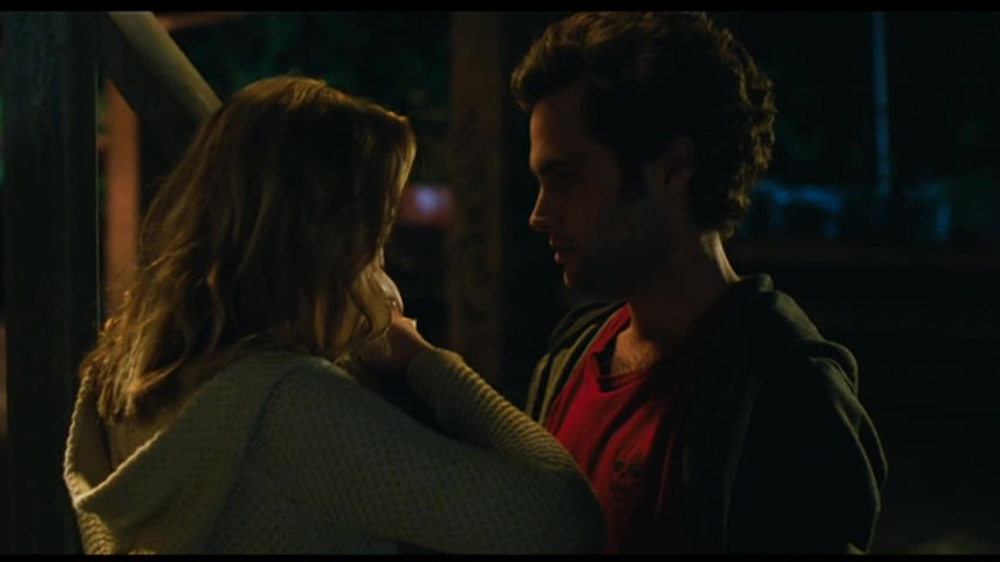
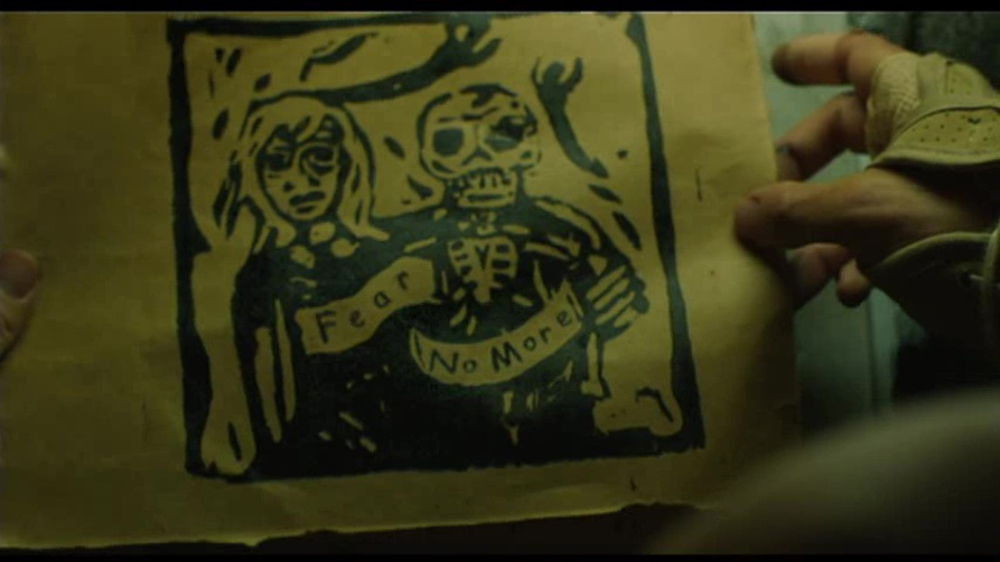
The artistic style of Posthumus’s woodcut resembles that of José Luis Guadalupe Posada, whose late nineteenth- and early twentieth-century engravings have become closely associated with El Dia de los Muertos: the Day of the Dead.10 This holiday is “a centuries-old Spanish Catholic tradition that exists to this day in Mexico and parts of the Southwest” (Bannatyne 94), or indeed in any part of the United States where there is a sizable Latin American population.
On the eve of All Souls’ Day, celebrants “visit the graves of their relatives to share food and wine,” along with elaborately decorated skulls made of sugar (Bannatyne 154). Like the Celtic feast of Samhain, the Day of the Dead is a liminal festival during which the dead may reputedly cross over into the world of the living and commune with their descendants. This festive element coincides well with 5.4 of Cymbeline, during which the sleeping Posthumus is visited by four of his deceased family members. Almereyda’s movie, however, features only the ghost of Sicilius Leonatus, the father of Posthumus, who reads part of an Emily Dickinson poem (“Of God we ask one favor”) written in a paper tablet notebook, which takes the place of the oracular tablet of Jupiter in Shakespeare’s romance. This substitution of a classic American literary figure for a pagan god parallels Almereyda’s overall replacement of the play’s mythological substructure with aspects of the Halloween celebration that originate in the fiction of Washington Irving.
Skulls also frequently appear in Almereyda’s film in the form of carved pumpkins. As David J. Skal notes, “the jack-o'-lantern is generally presented in its traditional form as a festive euphemism for the death's-head, the triangular nose hole and rictus grin being the ‘dead’ giveaways” (38-39). Cymbeline’s mansion is filled with organic and plastic jack-o'-lanterns, sometimes juxtaposed with skulls to emphasize this connection (see Figure 4). When Caius Lucius arrives at Cymbeline’s headquarters to collect the Roman tribute, one of the King’s biker henchmen is shown sitting at a desk. To his right, another plastic jack-o'-lantern wears a large round motorcycle helmet typical of the style favored by the members of Cymbeline’s gang (see Figure 5). This image connects the heads of the bikers to pumpkins/jack-o'-lanterns, which in turn links them to the figure of the Headless Horseman, whose steed finds its modern analogue in the motorcycles ridden by the King’s retainers, particularly his step-son Cloten (see Figure 6). When Cloten attempts to woo Imogen, she flees upstairs, and Cloten, as he passes a table on the stairway landing, puts his helmet on the table next to a jack-o'-lantern, where the camera lingers after the characters exit the frame, as if to reinforce the association between the two objects (see Figure 7).
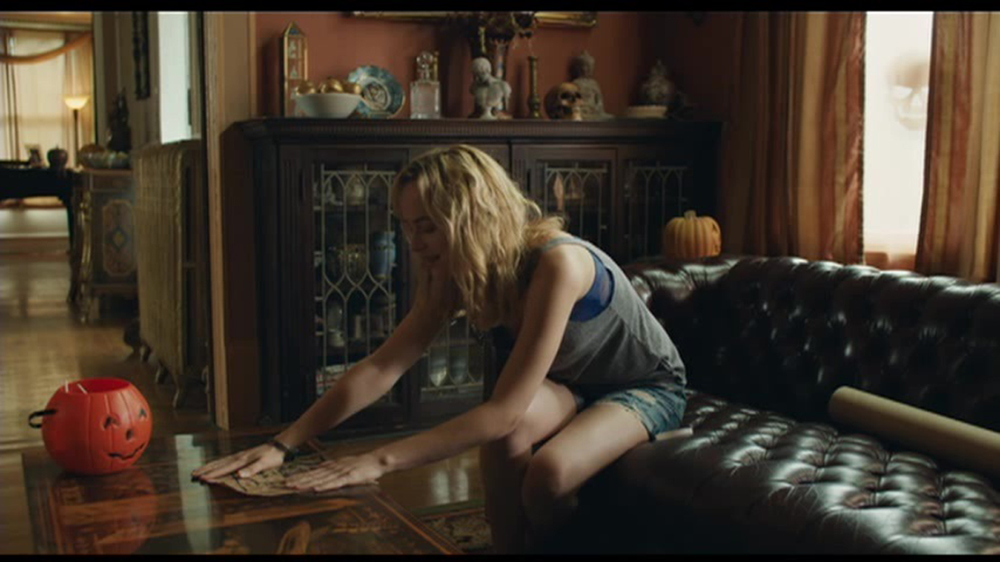
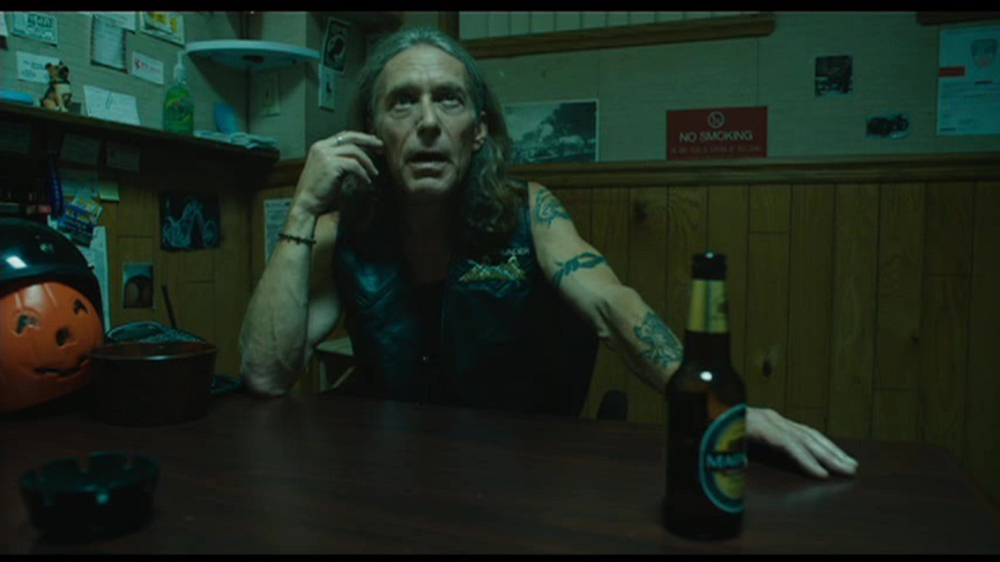
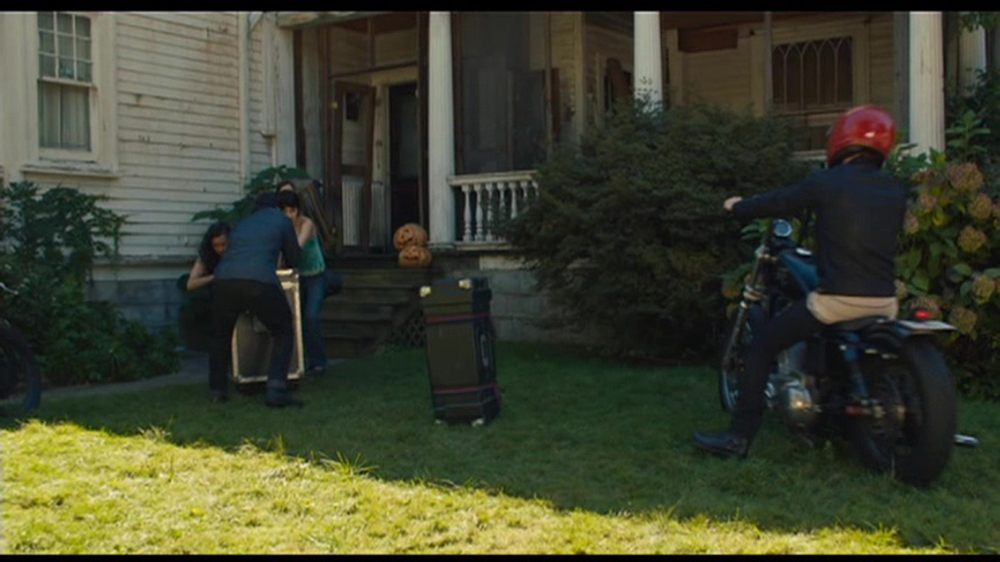
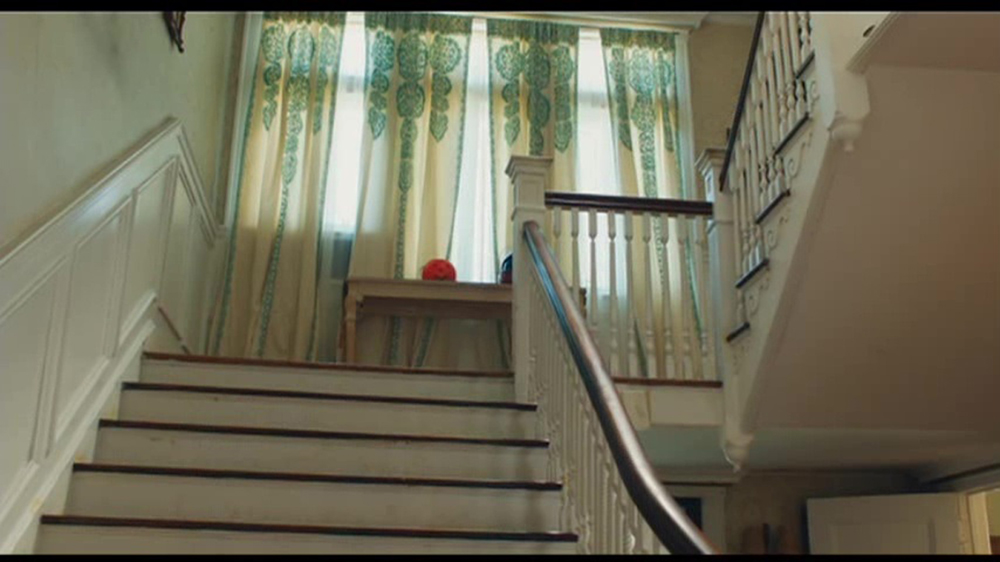
The film’s most ambiguous Headless Horseman figure materializes in a brief wordless segment that features Imogen’s first appearance disguised as Fidele. Devastated by Posthumus’s attempt to have her murdered for her supposed adultery, Imogen wanders alone through a field near “Milford Haven,” where she encounters a pumpkin-headed scarecrow wearing the mask of Guy Fawkes, the Gunpowder Plot conspirator who attempted to blow up Parliament in 1605 (see Figure 8). On the one hand, this figure is the “Guy,” a straw effigy of Fawkes annually paraded through the streets in England and burned in a great bonfire on November 5, the anniversary of the foiled attack. Due to the close proximity of Guy Fawkes Day to Hallowmas, “it was predictable that some of the souling rituals of Halloween would spill over to the Fifth of November” (Rogers 37). As Leslie Bannatyne explains, “Where once they had begged for ‘soul cakes’ in commemoration of All Saints' Day, boys now dressed in costume and begged for lumps of coal to burn their effigies of Guy Fawkes” (15). Despite the blending of these two autumnal festivals, effigies of the “Guy” are not traditionally depicted with the head of a pumpkin.

Scarecrows with jack-o'-lantern heads are, however, common yard decorations for the American celebration of Halloween (Morton 68; Rogers 159), and such a figure is explicitly linked to the Headless Horseman in an influential modern iteration of “The Legend of Sleepy Hollow,” which appears in Disney’s animated feature The Adventures of Ichabod and Mr. Toad (1949).11 Narrated by Bing Crosby, this 37-minute version of Irving’s legend
is notable for changing the tale's setting from simply “autumn” to very specifically Halloween. In the original tale, Ichabod is invited to “a merry-making or ‘quilting frolic[k]’”[284], but in the Disney adaptation he is not only invited to a Halloween party, but a party at which (as the narrator informs us), “Van Tassel always called upon his guests to tell him ghostly tales of Halloween” (Morton 185).
In fulfillment of his host’s request, Brom Bones sings a song entitled “The Headless Horseman” to chill the heart of Ichabod Crane, his rival for the hand of Katrina Van Tassel. During the song —which includes the lyric, “I’m telling you brother, it’s a frightful sight / To see what goes on Halloween night”—Brom decapitates with his sword a scarecrow with a jack-o'-lantern for a head (see Figure 9). At the climax of the tale, the Headless Horseman then carries (as his dismembered head) a similarly carved flaming jack-o'-lantern, which he hurls across the bridge at Ichabod. Through these images of decapitation, Disney’s version of Irving’s tale connects the image of a scarecrow with the head of a jack-o'-lantern to the Headless Horseman of “The Legend of Sleepy Hollow.”

Confronted with this strange apparition, the Imogen of Almereyda’s film is reminded of the woodcut of the girl and the cheerful skeleton sent to her by Posthumus, which she withdraws from her pocket and compares to the straw figure. Perhaps the scarecrow’s function to frighten away birds reminds her of the inscription “Fear No More,” but in the shot over Imogen’s shoulder, only the word “Fear” is visible across the torso of the girl in the engraving (see Figure 10). Now Imogen is alone and afraid, and she can no longer take consolation from her murderous husband’s message of reassurance. She lets go of the woodcut and allows it to be blown away by the wind, which symbolizes her abandonment of any hope of reunion with Posthumus. This conjunction of the cheerful skeleton (associated primarily with Posthumus) and the Headless Horseman (linked, up to this point, chiefly with Cloten) continues a motif in the film of conflating the two suitors for Imogen’s hand that derives from the evident interchangeability of the two men in Shakespeare’s play.
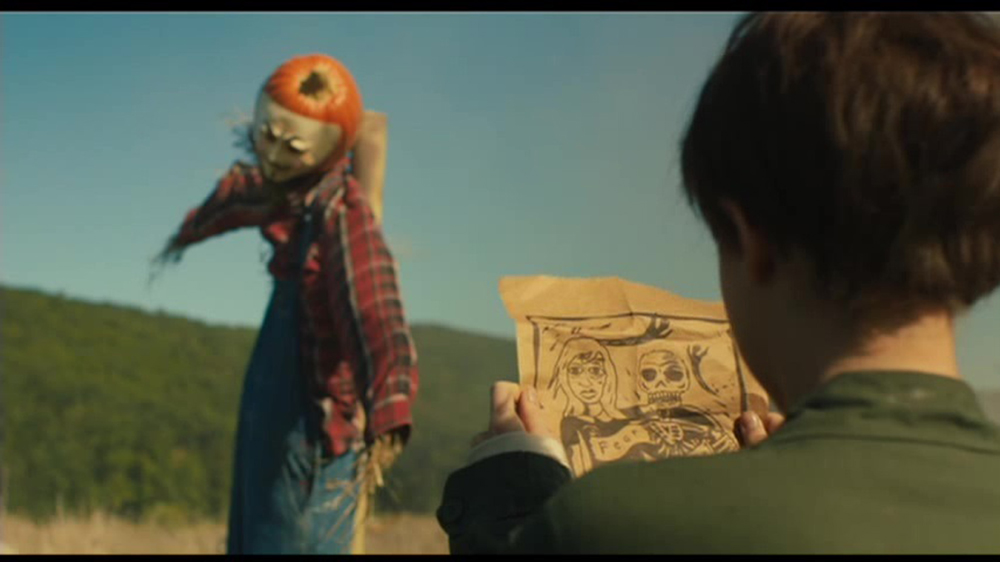
Several critics have explored the circumstantial and behavioral similarities between Posthumus and Cloten. For example, as James Edward Siemon writes, “They are paired in their relation to Cymbeline (the one his ward, the other his step-son); as rivals who seek first Imogen’s hand and later vengeance upon her; [and] as gamblers whom Iachimo easily outwits” (56).12 The play also stresses the physical resemblance between the two men. When Cloten first arrives at Milford Haven, he angrily contemplates Imogen’s romantic preference for Posthumus despite their similar appearances:
I mean, the lines of my body are as well drawn as his: no less young, more strong, not beneath him in fortunes, beyond him in the advantage of the time, above him in birth, alike conversant in general services, and more remarkable in single oppositions. Yet this imperseverant thing loves him in my despite. What mortality is! Posthumus, thy head, which now is growing upon thy shoulders, shall within this hour be off . . . . (4.1.9-17)
Cloten’s vow to remove Posthumus’s head from his shoulders ironically anticipates his own decapitation, and his observation that the lines of his body are as well drawn as those of Posthumus prepares the audience for Imogen’s inability to distinguish the headless trunk of Cloten from the frame of her own husband:
I know the shape of ’s leg; this is his hand,
His foot Mercurial, his Martial thigh,
The brawns of Hercules, but his Jovial face—
Murder in heaven? . . . O Posthumus, alas,
Where is thy head? (4.2.308-11, 319-20)
Imogen’s mistaken identification of Cloten’s corpse, even in the garments of Posthumus, is only plausible if the two men’s bodies display a comparable form. This similarity, combined with the fact that Posthumus and Cloten never appear on stage together, has led some commentators to suggest that Shakespeare intended the two roles to be played by the same actor, which would emphasize the way in which both men “lose their heads” in response to a perceived rejection by Imogen.13
In place of theatrical doubling, Almereyda uses Halloween imagery, specifically the skull T-shirt of Posthumus, to portray the conflation of the two characters. In a sequence from 2.3 of the play filmed but not included in the final product (Rome), Imogen tells Cloten that she holds the “meanest garment” of Posthumus in higher esteem than she holds her detested step-brother (2.3.133). Cloten recalls this insult later in the movie when he enters the absent Imogen’s room and finds, hanging in a doorway, Posthumus’s red shirt, which he rips down and twists in his hands as he recalls Imogen saying that “she held the very garment of Posthumus in more respect than my noble and natural person” (3.5.134-36). Cloten then tosses the T-shirt on Imogen’s bed and, when Posthumus’s man Pisanio enters, Cloten orders the servant to bring him the suit that Posthumus was wearing when he took his leave of his wife. After Pisanio exits to retrieve this clothing, Cloten lies back on the bed and begins a masturbatory fantasy about killing Posthumus and raping Imogen on her husband’s dead body. As the camera pans up to Cloten’s ecstatic expression, we observe that the back of his head has come to rest on the red T-shirt so that the black skull is directly aligned with his face (see Figure 11). This image foreshadows both the impending death of Cloten and Imogen’s inability to distinguish his headless body from that of her husband, the cheerful skeleton.
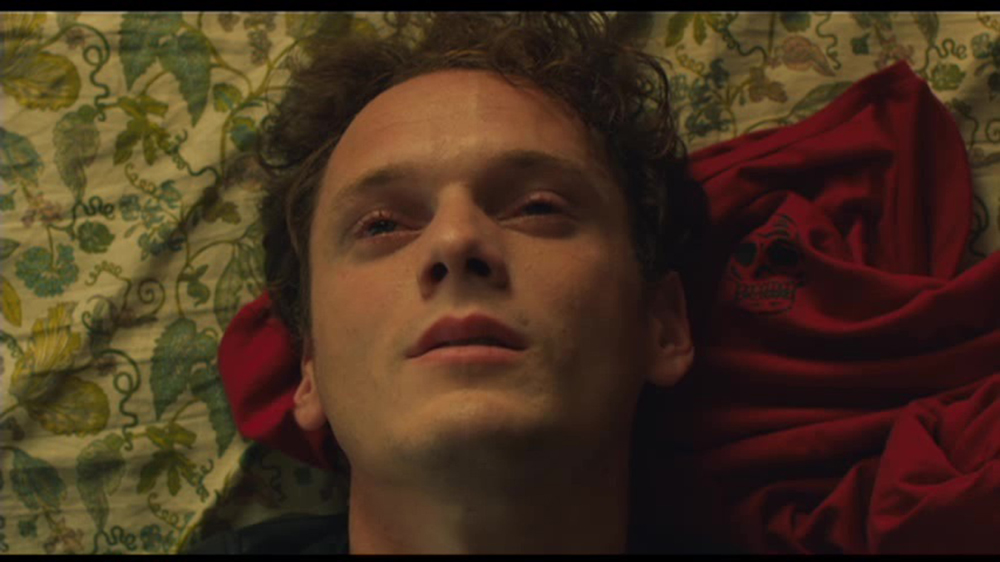
As in Shakespeare’s play, Almereyda’s film later naturalizes Imogen’s mistake by attiring Cloten in Posthumus’s clothes, but instead of the suit fetched for him by Pisanio, Cloten cycles to Milford Haven wearing the red T-shirt he has stolen from his step-sister’s bedroom. On his arrival, he discovers on the ground the woodcut that Imogen let fly in the wind, and after he reads aloud the artist’s signature (“Posthumus”), he rises to confront Guiderius (see Figure 12). This shot brings together many of the elements linking Cloten to the Headless Horseman, including his motorcycle/steed, his pumpkin-shaped helmet, and his imminent decapitation, but the image also strongly evokes Posthumus due to the presence of his skeleton woodcut, his “meanest garment,” and Cloten’s citation of his name. Although Irving’s tale preserves Brom Bones and Ichabod Crane as distinct figures, Almereyda’s film, prompted by Shakespeare’s play, ultimately collapses Cloten and Posthumus into the figure of the Headless Horseman to justify Imogen’s error in mistaking the headless trunk of one suitor’s dead body for the other’s. Indeed, Imogen later identifies Cloten’s headless corpse as that of Posthumus by unwrapping the canvas that contains it and revealing the skull on the red T-shirt (see Figure 13). Strictly, Imogen ought to know that Posthumus no longer possesses this shirt, since he mailed it to her own home, but in her shocked condition, she misapprehends her husband’s emblem for his bodily person.


In “The Legend of Sleepy Hollow,” Brom Bones asserts his masculine dominance over Ichabod Crane by appearing to suffer a deadly injury, decapitation (which frightens away his romantic competitor), yet Brom survives this “wound” to win the hand of the heiress Van Tassel: “Brom Bones too, who, shortly after his rival's disappearance, conducted the blooming Katrina in triumph to the altar, was observed to look exceedingly knowing whenever the story of Ichabod was related, and always burst into a hearty laugh at the mention of the pumpkin; which led some to suspect that he knew more about the matter than he chose to tell” (Irving 296). This portrayal of the ability to withstand wounds as a marker of masculine potency resembles Shakespeare’s own depiction of bodily injuries in his Roman plays. As Coppélia Kahn observes, such gashes destabilize the concept of gender by rendering a “feminine” weakness as a “masculine” strength:
In an obvious sense, wounds mark a kind of vulnerability easily associated with women: they show the flesh to be penetrable, they show that it can bleed, they make apertures in the body. But through the discursive operations of virtus, wounds become central to the signification of masculine virtue, and thus to the construction of the Roman hero. (17)
For a Roman general like Coriolanus, who voluntarily puts his body in harm’s way by engaging in battle, the scars that testify to the wounds he has received in combat provide the evidence that he possesses the masculine virtue necessary to become Consul. Although “one aspect of womanly incontinence” is the “inability to stop bleeding” (Paster 94), a woman who bleeds from a voluntary wound thereby appropriates the masculinity associated with such an injury.
For example, in Act 2 of Julius Caesar, Brutus’s wife Portia implores her husband to tell her the secret that is apparently torturing his mind. To demonstrate her trustworthiness to receive such a confidence, Portia reveals that she has been hiding a self-inflicted hurt:
I grant I am a woman, but withal
A woman that Lord Brutus took to wife.
I grant I am a woman, but withal
A woman well reputed, Cato’s daughter.
Think you I am no stronger than my sex,
Being so fathered and so husbanded?
Tell me your counsels, I will not disclose ‘em.
I have made strong proof of my constancy,
Giving myself a voluntary wound
Here, in the thigh. (2.2.293-302)
As Kahn remarks, “Portia concedes her inferiority as a woman, but nonetheless seeks entitlement to the constancy of a man, first through descent from her father . . . [and] next, through affiliation with Brutus” (99). By wounding herself voluntarily, by bleeding at her own behest, Portia inscribes upon her body the Roman sign of masculine virtue. Almereyda’s film version of Cymbeline enacts a similar construction of masculinity through its rendering of the scene of Imogen’s transformation from a princess to the boy Fidele.
In Shakespeare’s version of 3.4, Pisanio reveals to Imogen that his master has ordered him to kill her and to “send him / Some bloody sign of it” (3.4.124-25). Posthumus carries with him, at his next appearance, the counterfeit “bloody cloth” that Pisanio has provided to him (5.1.1), but Shakespeare does not stage the fabrication of this evidence. Almereyda, however, dramatizes the creation of this token by having Imogen wound herself as a way of demonstrating her masculine courage. Pisanio provides Imogen with male clothing and advises her, “If you could wear a mind dark as your fortune is, forget to be a woman.” He then draws his dagger and offers it to her with the exhortation, “Change.” I believe Pisanio intends for Imogen to use the dagger to cut off her long tresses (and indeed she later appears with her hair in a shorter, masculine style), but Imogen hears Pisanio’s appeal as an incitement for her to produce the “bloody sign” of her death, an act that will allow her to “forget to be a woman” and “change” into a man. She takes the dagger and replies, “I see into thy end, and am almost a man already,” at which point she slices into her left arm with Pisanio’s dagger (see Figure 14). Imogen uses the sweater tied around her waist to soak up the blood, and the sweater later becomes the “bloody cloth” that Pisanio sends to Posthumus. With determination, Imogen announces, “This attempt I am soldier to, and will abide it with a prince's courage”; afterwards, she turns and races into a toilet to clean her wound. On the Director’s Commentary, Almereyda points out, “And then she goes into the men’s room that’s behind her.” By inflicting upon herself a bodily injury that causes Posthumus to believe that she is dead, and yet surviving, Imogen transforms herself from a woman to a man, which demonstrates that, as in “The Legend of Sleepy Hollow,” masculinity inheres in the ability to withstand a “deadly” wound and yet go on living.
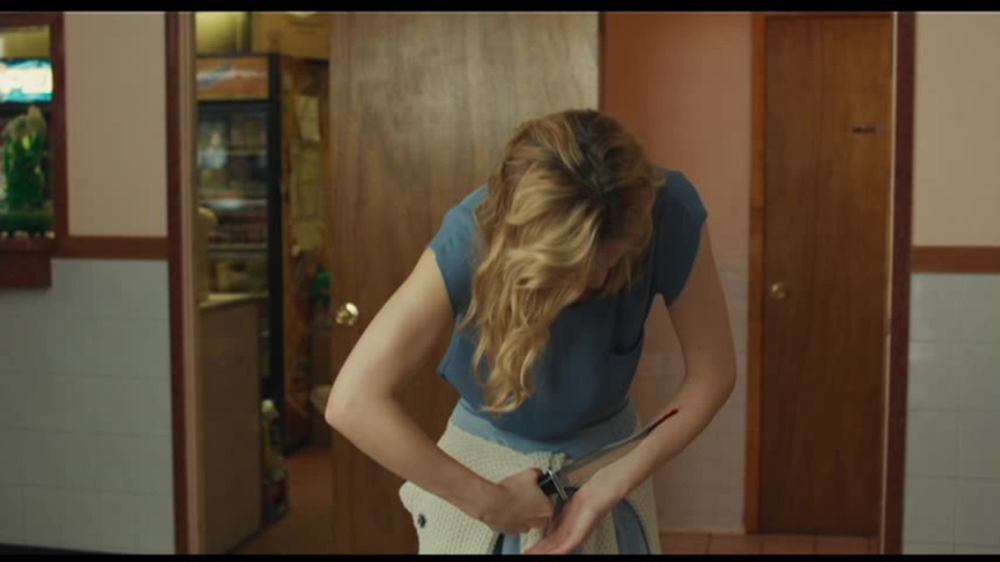
Posthumus, himself, from Imogen’s perspective, also survives a mortal wound and returns from the dead to rejoin his bride. Shortly thereafter in Almereyda’s film, Cymbeline resumes paying tribute to the Romans, but it is difficult to perceive the cynical renewal of payoffs from a drug-dealing motorcycle gang to a corrupt police force as the hopeful reconciliation usual to Shakespearean romance. By contrast, the stage play concludes with a joyous reinterpretation of the Soothsayer’s vision of an eagle vanishing in the beams of the sun, which is first read as an omen of the defeat of Britain, but is now understood as a portent of the happy reunification of Caesar’s Roman Empire and Cymbeline’s kingdom. Almereyda’s American version of the story, however, is not concerned with British nationalism, neither in its ancient origins nor its Jacobean preoccupation with bringing England, Wales, Scotland, and Ireland under one rule. As Almereyda states in an interview:
You know the play is about the forming of the British Empire . . . . King James had just risen to the throne, and Shakespeare in some ways was reflecting that [event] even though he’s talking about the deep past. He was acknowledging the recent ascension of King James, and all of that didn’t seem relevant to me. It wasn’t my concern. So the script became more focused on the relationships between men and women and less about empire and about warfare. (Rome)
For this reason, the film cuts all references to the Soothsayer’s vision and ends with an interpolated focus on its reunited lovers. Imogen, still dressed as a boy, takes Posthumus by the arm and drags him surreptitiously away from the other characters. She mounts a motorcycle, and Posthumus climbs on behind her, in a dependent position with his arms around her waist as they peel out of the deserted parking lot in which the final battle has taken place. Through this getaway, Imogen escapes from both the corruption of her father’s kingdom and any necessity to resume the vulnerable feminine role that she “forgot” by showing her masculine capacity to endure bodily mutilation. The film concludes with a close-up of Posthumus’s woodcut, lying on the ground in the parking lot sprinkled with broken glass. This final view of one version of the Headless Horseman figure, the cheerful skeleton, with his mate, reminds us that, as in Irving’s Halloween legend, the man who proves his masculinity by keeping his head, despite appearing to lose it, will ultimately defeat his rival for the hand of his beloved.
Notes
1 I exclude from consideration here Baz Luhrmann’s Romeo + Juliet (1996) and Julie Taymor’s The Tempest (2010) because neither is unambiguously set in the United States. Luhrmann’s “Verona Beach” has been associated with both Miami Beach and Venice Beach, but the movie was filmed in Mexico City and the cultural milieu of the setting is undoubtedly Hispanic. Taymor’s movie was filmed mainly in Hawaii, but most of the characters’ British accents and Renaissance costumes discourage any identification of the setting as modern-day America.
2 Other scholars who focus on the play’s concern with British national identity include Edwards 87-94, Floyd-Wilson 161-83, Jones 84-99, Kahn 160-70, King 47-91, Knight 129-67, Marcus 116-48, Mikalachki 301-22, and Parolin 188-215.
3 All quotations from Cymbeline refer to Valerie Wayne’s Arden 3 edition. Citations from other Shakespeare plays refer to Bevington’s Complete Works.
4 Quotations from Almereyda’s Cymbeline, including the Director’s Commentary, are based on my own transcriptions.
5 Greg Smith asserts that Irving’s tale “has transcended its status as American short-story to become a part of our cultural mythology” (174-75).
6 Alisa Grant Ferguson employs this passage in the title of her article analyzing Almereyda’s use of Halloween “background signifiers” to replace Yorick’s skull from the gravedigger scene in Hamlet (5.1), which the director omits entirely from his film version (128). Ferguson identifies three clear functions of Halloween in Almereyda’s earlier movie: “First, the overt memento mori of the death's head emblem is deconstructed and recoded in the form of multitudinous Halloween skulls and apotropaic pumpkins. Second, the consumerism surrounding the festival of Halloween is tied into a carnivalistic response to postmodern angst over capitalist autocracy. Third, and most obvious of all, the film utilizes Halloween as a signifier of the horror genre” (131).
7 It is, perhaps, worth noting that one of Tim Burton’s films, Sleepy Hollow (1999), is loosely based on Irving’s tale.
8 Two online reviewers (Rooney and Sharkey) claim that the film is set in Scranton, PA, but I have been unable to find any independent confirmation of this detail. In his Director’s Commentary, Almereyda divulges, “I wanted to shoot in Pennsylvania, but . . . the budget steered us to home turf: New York.”
9 Hoping to capitalize on the resemblance between the film’s biker milieu and that of the popular television series Sons of Anarchy, the distributors of Almereyda’s Cymbeline temporarily changed the movie’s title to Anarchy, and official trailers were released under that name, which prompted dozens of reviewers to link the film to the television show. However, in an online interview, Almereyda himself has denied the indebtedness of his screenplay to Sons of Anarchy: “This was written before the advent of that little show called Sons of Anarchy, which I really haven’t seen. So it’s an embarrassing reflection of my own delusion, my own stubbornness, that I was thinking of Roger Corman movies, Wild Angels, I was thinking of friends of mine who had experience with bikes and bikers, and I wasn’t paying attention to TV. And maybe that’s sinful, but I was rankled when Jupiter tried to retitle the film, but I couldn’t really control it. I was glad that they went back to the original title. I watched half an episode [of Sons of Anarchy] on the back of an airplane seat, and I didn’t think it had much to do with Shakespeare, even though I’ve been told it has a lot to do with Hamlet. And stylistically, the mood, the tone, the look of it, I don’t think has much if anything to do with my movie” (Mears). Although Sons of Anarchy was apparently not a conscious source for Cymbeline (as I am arguing that “The Legend of Sleepy Hollow” was), the circumstances of the film’s release have retroactively associated Almereyda's work with the subsequent biker drama.
10 New Kittredge editor Hannah C. Wojciehowski points out that the “woodblock print features a girl, a skeleton, and flying ghosts, in keeping with the film's Day of the Dead theme” (24n).
11 In Irving’s original story, it is Ichabod who is described as being so lanky that one might mistake him for a “scarecrow eloped from a cornfield” (274).
12 Among the other critics who examine the physical and behavioral resemblance between Cloten and Posthumus are Bruster 108, Hartwig 81, Hunter 156-58, and Swander 251-53.
13 For a discussion of the likelihood of this doubling on the early modern stage, as well as brief accounts of contemporary examples of such casting, see Booth 122-23, Bruster 112n, Siemon 56n, Swander 251, and Warren 89-91.
Works Cited
Algar, James, Clyde Geronimi, and Jack Kinney, dirs. The Adventures of Ichabod and Mr. Toad.Disney, 1949. Video.
Almereyda, Michael, dir. Cymbeline. Benaroya, 2014. DVD. “Anthony Katagas: Biography.” Internet Movie Database. N. d. Web. 4 Jan. 2016.
Bannatyne, Lesley Pratt. Halloween: An American Holiday, an American History. Pelican, 1998.
Bevington, David. The Complete Works of Shakespeare. 5th ed. U of Chicago P, 2004.
Booth, Stephen. “Speculations on Doubling in Shakespeare’s Plays.” Shakespeare: The Theatrical Dimension. Ed. Philip C. McGuire and David A. Samuelson. AMS, 1979. pp. 103-31.
Bruster, Douglas. “Cymbeline and the Sudden Blow.” Upstart Crow, vol. 10, 1990, pp. 101-12.
Edwards, Philip. Threshold of a Nation: A Study in English and Irish Drama. Cambridge UP, 1979.
Ferguson, Alisa Grant. “’Tis now the very witching time of night’: Halloween Horror and the Memento Mori in Hamlet (2000).” Journal of Adaptation in Film & Performance, vol. 5, 2012, pp. 127-46.
Floyd-Wilson, Mary. English Ethnicity and Race in Early Modern Drama. Cambridge UP, 2003.
Friedman, Michael D. “Introduction: ‘To think o’ th’ teen that I have turned you to’: The Scholarly Consideration of Teen Shakespeare Films.” Shakespeare Bulletin, vol. 26, no. 2, 2008, pp. 1-7.
Hartwig, Joan. Shakespeare’s Tragicomic Vision. Louisiana State UP, 1972.
Hunter, Robert Grams. Shakespeare and the Comedy of Forgiveness. Columbia UP, 1965.
Irving, Washington. “The Legend of Sleepy Hollow,” The Sketch Book of Geoffrey Crayon, Gent. Ed. Haskell Springer. The Complete Works of Washington Irving. Vol. 8. Twayne, 1978. pp. 272-97.
Jones, Emrys. “Stuart Cymbeline.” Essays in Criticism, vol. 11, 1961, pp. 84-99.
Kahn, Coppélia. Roman Shakespeare: Warriors, Wounds, and Women. Routledge, 1997.
King, Ros. Cymbeline: Constructions of Britain. Ashgate, 2005.
Knight, G. Wilson. The Crown of Life: Essays in Interpretation of Shakespeare's Final Plays. Barnes, 1966.
Maley, Willy. “Postcolonial Shakespeare: British identity formation and Cymbeline.” Shakespeare’s Late Plays: New Readings. Ed. Jennifer Richards and James Knowles. Edinburgh UP, 1999. pp. 145-57.
Marcus, Leah S. Puzzling Shakespeare: Local Reading and Its Discontents. U of California P, 1988.
Mears, Steven. Interview with Michael Almereyda. Filmcomment. 13 March 2015. Web. 30 Sep. 2015.
Mikalachki, Jodi. “The Masculine Romance of Roman Britain: Cymbeline and Early Modern English Nationalism.” Shakespeare Quarterly, vol. 46, 1995, pp. 301-22.
Parolin, Peter A. "Anachronistic Italy: Cultural Alliances and National Identity in Cymbeline."Shakespeare Studies, vol. 30, 2002, pp. 188-215.
Paster, Gail Kern. The Body Embarrassed: Drama and the Disciplines of Shame in Early Modern England. Cornell UP, 1993.
Rome, Emily. “Interview: ‘Cymbeline’ director Michael Almereyda on reuniting with Shakespeare and Ethan Hawke.” Hitfix. 13 Mar. 2015. Web. 19 Sep. 2015.
Rogers, Nicholas. Halloween: From Pagan Ritual to Party Night. Oxford UP, 2002.
Rooney, David. Rev. of Cymbeline. Dir. Michael Almereyda. Hollywood Reporter. 3 Sep. 2014. Web. 28 Sep. 2015.
Sharkey, Betsy. “‘Cymbeline’ in the Instagram age; an intriguing idea that misses.” Los Angeles Times. 12 Mar. 2015. Web. 19 Sep. 2015.
Siemon, James Edward. “Noble Virtue in ‘Cymbeline.’” Shakespeare Survey, vol. 29, 1976, pp.51-61.
Skal, David J. Death Makes a Holiday: A Cultural History of Halloween. Bloomsbury, 2002.
Smith, Greg. “Supernatural Ambiguity and Possibility in Irving’s ‘The Legend of Sleepy Hollow.’” Midwest Quarterly, vol. 42, 2001, pp. 174-82.
Swander, Homer D. “Cymbeline: Religious Idea and Dramatic Design.” Pacific Coast Studies in Shakespeare. Ed. Waldo F. McNeir and Thelma N. Greenfield. U of Oregon P, 1966. pp. 248-62.
Warren, Roger. Staging Shakespeare’s Late Plays. Clarendon, 1990.
Wayne, Valerie, ed. Cymbeline. By William Shakespeare. Arden Shakespeare. 3rd ed. Bloomsbury, 2017.
Wojciehowski, Hannah C., ed. Cymbeline. New Kittredge Shakespeare. Focus, 2015.